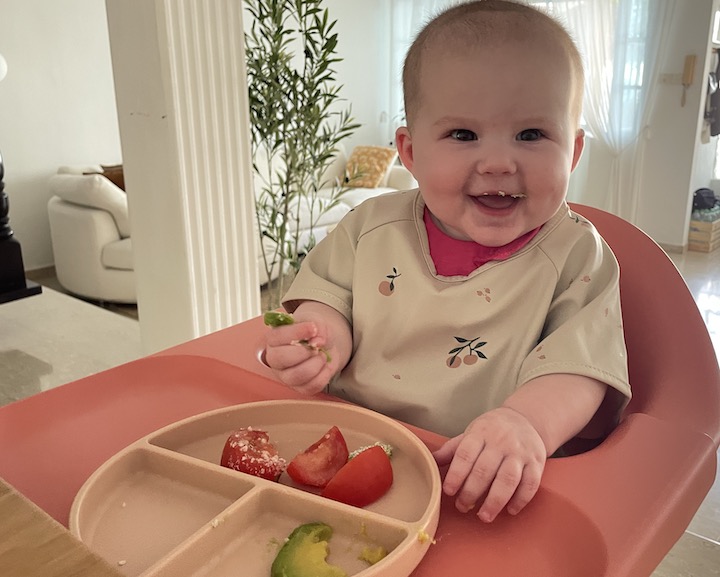
How to get started on baby-led weaning, how to prep solid foods safely for your baby, what equipment you’ll need, and the all-important difference between gagging and choking
If you are looking to get your baby on solid foods and are considering baby-led weaning, you’ve come to the right place! We’ve already covered what baby-led weaning is and how it differs to traditional weaning on puree foods. We’ve also discussed the pros and cons of each weaning method and the key signs to look for to check your baby is ready to start on solid foods.
In this article we will look at how to get started with baby-led weaning practically, how to prep foods, what tools you’ll need, what foods to start with and avoid, and how to distinguish between gagging vs choking. So let’s get to it!
Read more: Introductory Guide to Baby-Led Weaning: Pros, Cons & Signs Your Baby is Ready
Baby-Led Weaning: How to Get Started
Planning your baby’s first baby-led weaning meal: When your baby is 6 months old, start with finger foods, i.e strips of veggies, fruits, cooked meat etc. If the strips of fruit or veg are slippery, try dusting them with a little baby cereal. From 7 months onwards you can start offering your baby modified versions of your family food with mild variations (minus salt, sugar, honey, chilli).
- Finger foods can be kept on your baby’s tray or plate so that they can pick up with their hands
- Pulpy foods such as sauces, gravies, yoghurt, oatmeal etc can be offered to your baby on a pre-loaded spoon. Place the pre-loaded spoon on their tray so they can pick it up themselves. They might not get the hang of using the spoon right away but they will get better with practice.
- Meat, Poultry, Fish, Eggs– You can introduce all of this after 6 months.
Foods to avoid when introducing solids
During your baby’s first 12 months avoid these foods:
- Honey
- Raw meats and seafood
- Unpasteurised milk, unpasteurised cheese and deli meat
- Undercooked eggs
- High-mercury fish
- Salt
- Sugar
- Limit highly processed foods
- Be mindful of choking hazards (whole grapes and whole cherry tomatoes, raw carrots and other crunchy veg). Avoid giving your baby foods that won’t dissolve in the mouth, or can’t be mashed with the gums until the molars come in around 12 months.
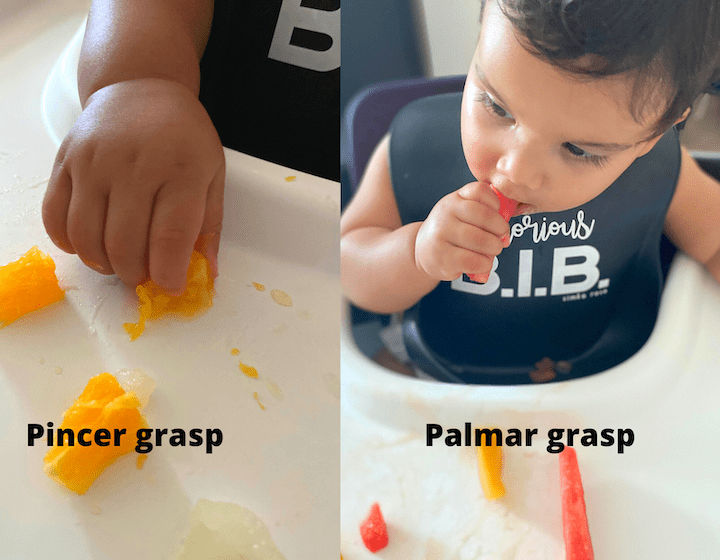
How to prepare food for baby-led weaning
From 6 months onwards
At this age, babies only have the palmar grasp (grabbing foods by the fist) hence all the fruits, vegetables and other foods have to be cut into finger-length size so that your baby can easily hold it by hand.
Tip: cut the food into 1 to 2 adult finger widths wide, and 1.5 to 2x the length of your baby’s fist.
Types of finger food: Any vegetables like cooked carrot, cooked broccoli or cooked cauliflower spears, cooked sweet potato, plus fruits etc.
From 8-months onwards
Babies start to develop the pincer grasp (using thumb and index finger to pick up smaller objects). At this stage, food can be cut into smaller pieces.
Serve food cut into small pieces, like ripe fruit chunks, cooked beans, chopped steamed spinach, and pieces of pasta.
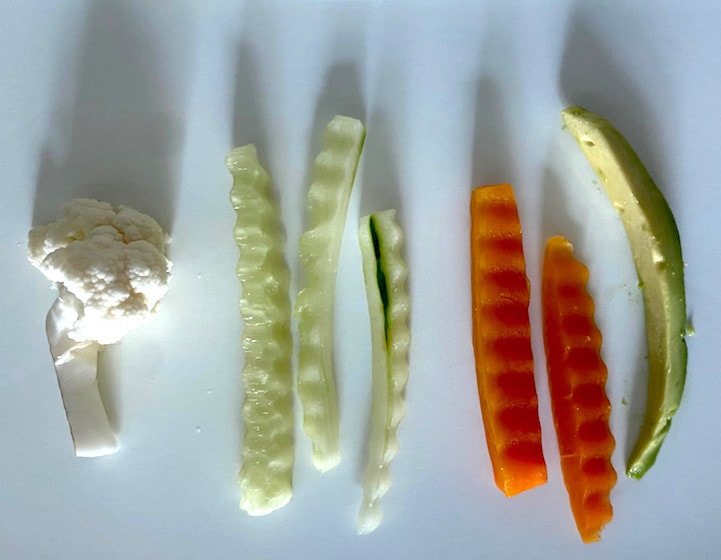
Baby-led weaning food prep tips
Some of the foods tend to be slippery and your baby might get frustrated if they are unable to hold the food. Use a crinkle cutter to chop the food and give it some texture so that the baby can hold on to the strips easily. Alternatively, you can coat the food with powdered oats to make it less slippery
Softer fruits and veggies like bananas, peaches, etc can be offered raw. Harder ones should be steamed, roasted, pan-fried. The consistency of the fruits and veggies should be tender, yet firm enough for a baby to hold.
Read more: Signs Your Baby is Ready for Solid Food
How to serve a baby-led weaning meal

Where to eat: Pick the same feeding spot for your baby every day so they get familiar with it. Place your baby’s highchair next to your dining table so they can join the family at mealtimes. You can place food on the high-chair tray and transition to serving food on a plate once your baby becomes more adept at feeding themselves.
Meal timings The ideal time to give your baby their meal would be approx.30 mins – 1 hr after your baby’s normal milk feed and post-nap. Your baby will be well-rested, and alert and may feel a little peckish.
Give your baby plenty of time to explore the food when you start. They might not understand what’s required of them and it might take some time to warm up to eating solid food. Follow your baby’s cues. Mealtimes should be fun and pleasurable for your baby. The moment your baby turns away acts disinterested or gets annoyed, it would be a good time to end the meal. Don’t extend mealtime beyond 30 mins.
Note: Don’t replace any milk feed with solid meals. Till 12 months of age, solids should always be offered in addition to the existing milk feeds. Solid foods will complement milk and should be added to your baby’s already established milk schedule. Till your baby’s first year, milk (breast milk or formula) will continue to be a significant part of their nutrition.
This will continue till their solid food diet is varied enough to offer the correct balance of nutrients. You’ll need to trust your baby’s ability to increase solid food intake and decrease milk (usually happens later in the first year).
How much to eat per meal: Offer 1-2 strips of finger food in the beginning. Follow your baby’s cues. Don’t force-feed if your baby refuses to eat. Don’t focus on how much they eat. Even if your baby manages to eat a few bites, it’s ok. Give a variety of foods for your baby to try and don’t give the same thing every day.
There is no ideal portion size as all babies eat different amounts of food. There might be days when they might eat a lot or not eat at all. Your baby might become disinterested in food if they are unwell or teething. Each day is a new day – keep offering different foods.
How many meals a day should your baby eat (in addition to milk)?
Month 6– Start with 1 meal. Finger foods
Month 7– 1 meal a day. Add a snack based on his hunger cues
Month 8– Introduce 2 meals and a snack on demand
Month 9 onwards– Add 3 meals and a snack on demand
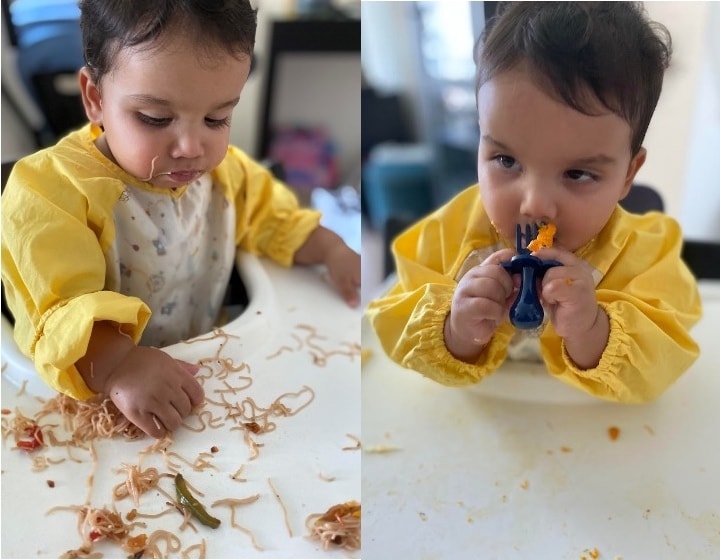
What if your baby doesn’t like a type of food?
If your baby dislikes a particular food, try it again after a few days. You may have to offer the same food multiple times till they begin to start accepting it. You can also try modifying the food and re-introducing it. eg. If they don’t like bananas, you can combine bananas and oatmeal and offer it after a few days.
You might notice the following with your baby when you introduce solids and all these are normal reactions to food: grabbing food, throwing, smushing, playing with the food, ignoring food.
Tip: Maintain a food diary and track the foods that your baby is eating, likes and dislikes. This helps you plan your baby’s meals better.
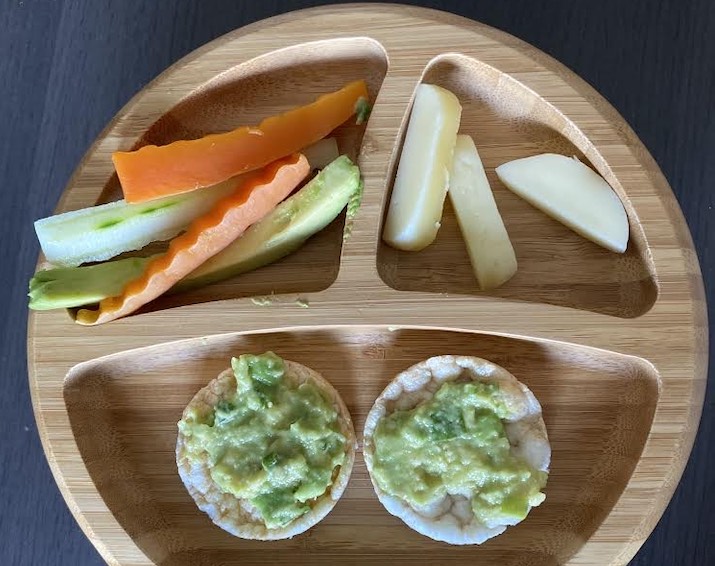
What to serve for a balanced baby-led weaning meal
Your baby should eat a balanced meal with a variety of fresh nutritious foods and each meal should ideally consist of the following:
- Fibre- Fruits and Veggies
- Carbohydrates – (pasta, potato, rice)
- Protein – lentils, soya, meat, fish, dairy products (full-fat cheese, butter etc)
- Healthy fats – nut butter, ground seeds, meat
Temperature of food: You can expose your baby to a variety of temperatures so that it makes feeding easier in the long run. Cold foods are great during teething. When heating food be careful about not creating hot spots.
This can usually happen if you heat food via a microwave. Once heated, let the food cool for a few minutes and stir it so that the heat is evenly distributed. Don’t forget to test the temperature on your wrist before you serve it to your baby.
How do you know if your baby is eating enough solid food?
Check the poop! If their poop is yellowish, their diet will mainly consist of milk and they may not be eating enough solids. If their poop is brown, this indicates they are eating a good amount of solids.
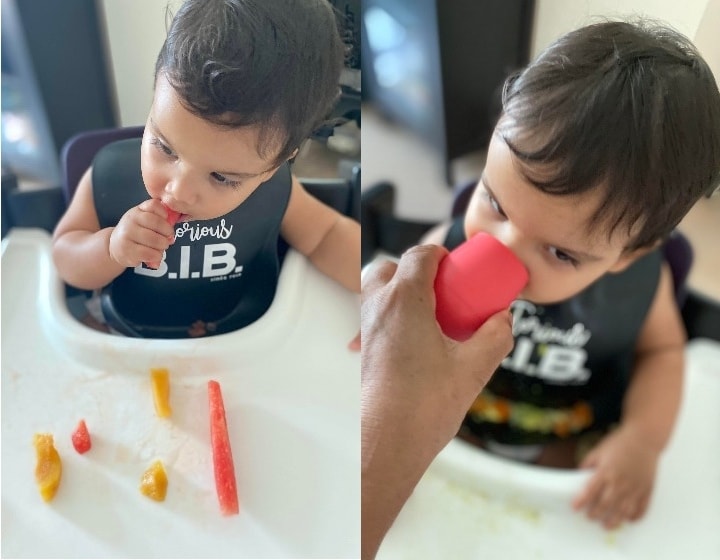
Tips to encourage your baby to eat solid food
- Include your baby at family mealtimes as this is a great opportunity for them to watch and observe the rest of the family eating. Babies love mirroring their parents and this is the fastest way for them to learn.
- Demonstrate how to eat and chew by using exaggerated jaw movements.
- Make the food look exciting by offering variety at each meal. Babies should eat the rainbow, so make sure to include colours on their plate – fruits, vegetables and other food that your family eats.
- Season the food with herbs and spices to make it more flavourful. Baby food doesn’t have to be bland or boring.
- Make mealtimes a positive experience. Always keep a happy face even if you are upset with your baby’s behaviour. You can keep your frustration level down by going into the meal with zero expectations.
Gagging vs Choking
Gagging is a normal part of the weaning process. The most recent Pediatrics research suggests that there is no greater risk of choking with baby-led weaning in comparison to traditional weaning with purees. Gagging is often confused with choking. Gagging is a normal protective reflex that is designed to stop your baby from choking.
As your baby learns to eat and gains better oral motor control, gagging will gradually reduce. The best way to gain confidence and overcome the fear of gagging and choking is by doing an infant CPR course before you begin the weaning process. Also, watch baby gagging videos on YouTube to recognize signs of gagging.
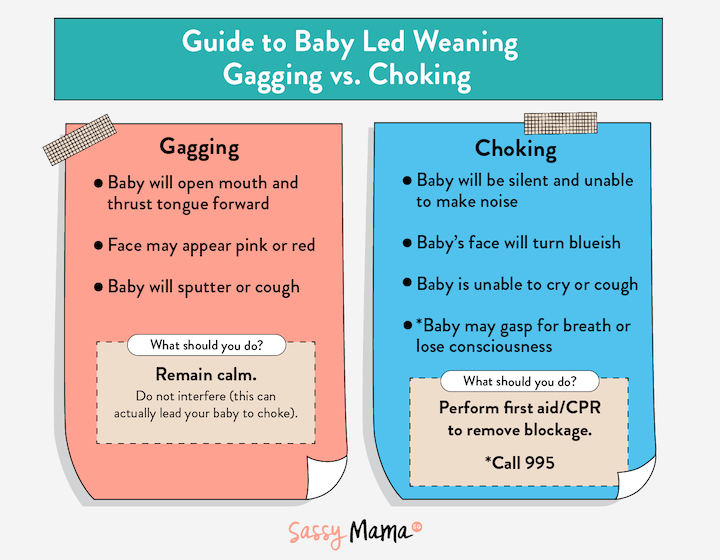
What should you do if your baby starts gagging?
– Don’t interfere as this can actually cause choking. Stay calm and watch your baby.
– Don’t fish food out of your baby’s mouth using your finger as this can actually push the food further into their mouth. Your baby will be able to sort themselves out and return to eating normally after gagging.
– Offer sips of water once your baby has cleared their mouth.
Way to reduce the risk of choking
-
- Ensure baby always eats in an upright and seated position
- Introduce solids only when your baby is developmentally ready, typically at 6 months and is displaying all these signs of readiness
- Don’t attempt to put your finger into your baby’s mouth and remove the food as it can push it further down.
- Identify signs of choking and know how to react. if required, perform CPR. Learn infant first-aid before you begin the weaning process.
- Always be watchful and supervise your baby eating
- Avoid foods that pose a choking hazard. Eg. Skins, seeds, whole nuts, pits, popcorn, nut butter that aren’t watered down etc. Avoid hard and round fruits such as whole grapes, cherries etc. Avoid hard and crunchy food such as raw apples, raw carrots etc.
- Offer foods in the right shape, texture and size for your baby’s developmental stage. AAP recommends that any foods larger than half an inch in size be cut up further.
Note: Six-month-old babies are developmentally ready to eat solid finger foods (assuming the baby wasn’t born prematurely). It’s very unlikely that your baby will actually choke on food if you have followed the general safety rules of how to cut and serve food to your baby.
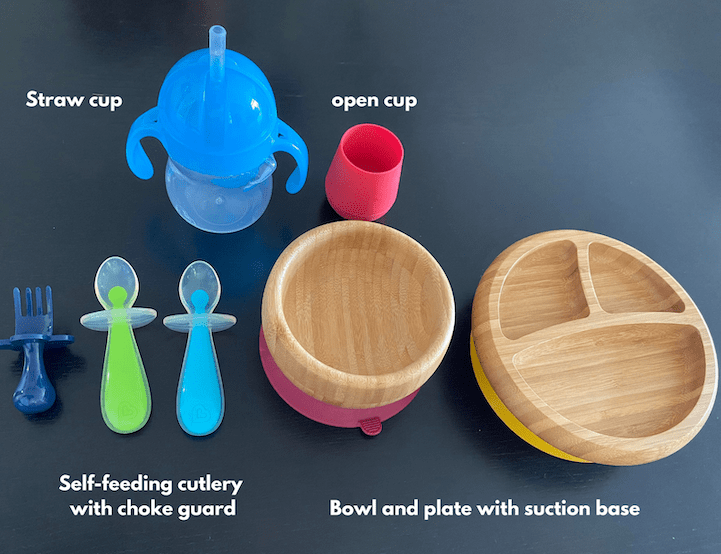
Baby-led weaning equipment
Here is a list of our favourite tools that made our feeding journey much easier. We are minimalist parents and invested only in the essentials.
1. High chair with a harness, footrest and tray – Baby-led weaning gets really messy so you will want to buy an easy-to-clean high-chair. Skip the high chairs with cushions and crevices as it can get difficult to clean. An adjustable highchair that grows along with your baby and that can be lowered or raised to allow sitting at the table is useful.
We found a footrest essential as it will give your baby good posture, core support and stability required for feeding. You will need a five-point harness for safety reasons.
2. Soft bib – choose a bib like the BapronBaby bib by Mama Yay! which is recommended by many feeding specialists to be a safe and comfortable bib that ties around your baby’s back without constricting the neck like a traditional bib and offers full coverage.
3. Splash mat – If you have hardwood floor, carpet or fancy flooring you might need a splash mat or a plastic mat below your high-chair to protect your floor from extra mess.
4. Plates and bowls with suction base. We like divided plates because we can place the different components of a meal in different sections. However, you can choose a plate with one area for food as well. Bowls are great for thicker or mashed food like yogurt, gravies, oatmeal, dips etc.
5. Cups (straw cups and open cups). We use the silicone open cup from EZPZ which is a perfect size for little hands. For straw cups, your baby can start with a weighted spill-proof straw cup with handles so that your baby can drink from any angle.
6. Spoon and fork- A set of self-feeding fork and spoon set. We like the ones from EZPZ, Grabease, Oxo Tot and Numnum Gootensils (these have dimpled heads to catch softer foods and blends).
Good luck with your baby-led weaning!
As I mentioned earlier, there is no right or wrong way to feed your baby. Also, each baby is different. Few babies thrive on purees, others on finger foods. Be flexible, follow your intuition, your baby’s developmental signs and modify your feeding approach accordingly.
That being said Baby-Led Weaning has a positive impact on a baby’s long term eating habits and their developmental aspects as well. If you have chosen to go with BLW, gather all the information possible by speaking to other parents and by doing thorough research. This will make you confident and turn your baby’s weaning journey a successful one.
Baby-Led Weaning Resources:
- Baby-led weaning support groups: Baby-Led Weaning (BLW) Singapore
- Baby-led weaning online courses: Feeding Littles, Solid Starts and Fortified Fam.
- Infant CPR/first-aid course. You and your baby’s caregivers must take a first-aid course so that you can be more confident while your baby learns to self-feed.
- Baby-led weaning recipes:
www.annabelkarmel.com
www.superhealthykids.com
weelicious.com
onehandedcooks.com.au
www.myfussyeater.com






 View All
View All



 View All
View All









 View All
View All



![[𝗦𝗔𝗩𝗘 𝗧𝗛𝗜𝗦] 𝗞𝗶𝗱-𝗙𝗿𝗶𝗲𝗻𝗱𝗹𝘆 𝗖𝗮𝗳𝗲𝘀 𝗪𝗶𝘁𝗵 𝗙𝗥𝗘𝗘 𝗣𝗹𝗮𝘆 𝗔𝗿𝗲𝗮𝘀
If you’ve ever needed a cuppa while your kids had way too much energy to sit still, these cafes and restaurants are the places to go! They have dedicated play areas and playgrounds where your little ones can run, jump and play while you sit back, relax and enjoy your drink in peace.
Comment “Play” for more kid-friendly restaurants and cafes to visit!](https://www.sassymamasg.com/wp-content/plugins/instagram-feed/img/placeholder.png)
